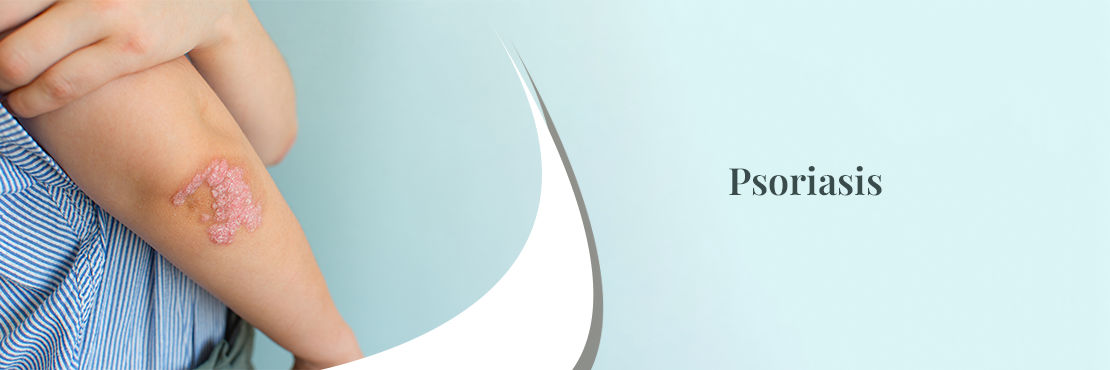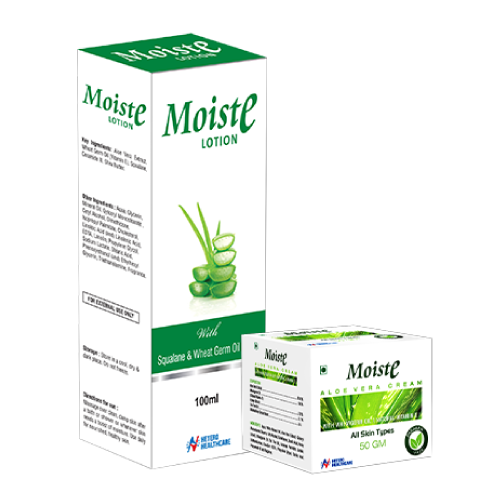Psoriasis

Psoriasis is an immune-mediated disease* (a disease with an unclear cause that is characterized by inflammation caused by dysfunction of the immune system) that causes inflammation in the body. There may be visible signs of inflammation, such as raised plaques (plaques may look different for different skin types) and scales on the skin.
This occurs because the overactive immune system speeds up skin cell growth. Normal skin cells grow and shed (fall off) in a month. With psoriasis, skin cells do this in only three or four days. Instead of shedding, the skin cells pile up on the skin's surface. Some people report that psoriasis plaques itch, burn, and sting. Plaques and scales may appear on any body part, although commonly found on the elbows, knees, and scalp.
Inflammation caused by psoriasis can impact other organs and tissues in the body. As a result, people with psoriasis may also experience other health conditions. For example, one in three people with psoriasis may also develop psoriatic arthritis. Signs of PsA include swelling, stiffness, and pain in the joints and areas surrounding the joints. Unfortunately, PsA often goes undiagnosed, particularly in its milder forms. However, treating PsA early on is essential to help avoid permanent joint damage.
Symptoms often start between ages 15 and 25 but can begin at any age. Men, women, and children of all skin colors can get psoriasis.
What are the types of psoriasis?
There are several types of psoriasis, including:
- Plaque psoriasis: Plaque psoriasis is the most common type of psoriasis. About 80% to 90% of people with psoriasis have plaque psoriasis.
- Inverse psoriasis: This type appears in your skin folds. It causes thin plaques without scales.
- Guttate psoriasis: Guttate psoriasis may appear after a sore throat caused by a streptococcal infection. It looks like small, red, drop-shaped scaly spots and often affects children and young adults.
- Pustular psoriasis: Pustular psoriasis has small, pus-filled bumps on top of plaques.
- Erythrodermic psoriasis: This is a severe type of psoriasis that affects a large area (more than 90%) of your skin. It causes widespread skin discoloration and skin shedding.
- Sebopsoriasis: Sebopsoriasis typically appears on your face and scalp as bumps and plaques with a greasy, yellow scale. This is a cross between psoriasis and seborrheic dermatitis.
- Nail psoriasis: Nail psoriasis causes skin discoloration, pitting, and changes to your fingernails and toenails.
What part of my body will psoriasis affect?
A psoriasis rash can show up anywhere on your skin. Psoriasis is common on your:
- Elbows and knees.
- Face and inside of your mouth.
- Scalp
- Fingernails and toenails.
- Genitals.
- Lower back.
- Palms and feet.
In most people, psoriasis covers a small area of their skin. However, the plaques connect and cover a large body area in severe cases.
What is psoriatic arthritis?
Psoriatic arthritis is a type of arthritis that causes joint pain and swelling. Like psoriasis, psoriatic arthritis is an autoimmune condition that causes your immune system to function abnormally and cause symptoms. About 1 in 3 people diagnosed with psoriasis will also develop arthritis due to inflammation. Early treatment of psoriatic arthritis can reduce damage to your joints.
What does psoriasis look like?
Symptoms of psoriasis on your skin include plaques. The plaques look like this:
- A rash or a raised area of thick skin.
- The skin on the plaque is discolored.
- The plaque is scaly or flaky and sheds quickly.
An early sign of psoriasis is small bumps. The bumps grow, and scales form on top. The plaque's surface might shed, but the scales beneath them will stick together. If you scratch your rash, the scales may tear away from your skin. This can cause bleeding. As the inflammation grows, lesions and more significant areas of skin damage can form. Symptoms of psoriasis can range from mild to severe.
What are the symptoms of psoriasis?
In addition to skin plaques or a rash, you might have symptoms that include:
- Itchy skin.
- Cracked, dry skin.
- Skin pain.
- Nails that are pitted, broken, or crumbly.
- Joint pain.
If you scratch your plaque, you could break open your skin, leading to an infection. Infections are dangerous. You have disease symptoms if you experience severe pain, swelling, and a fever. Contact your healthcare provider if you have these symptoms.
What causes psoriasis?
An over-reactive immune system that creates inflammation in your skin causes psoriasis. If you have psoriasis, your immune system is supposed to destroy foreign invaders, like bacteria, to keep you healthy and prevent you from getting sick. Instead, your immune system can mistake healthy cells for foreign invaders. As a result, your immune system creates inflammation or swelling, which you see on the surface of your skin as skin plaques.
It usually takes up to 30 days for new skin cells to grow and replace old ones. However, your over-reactive immune system causes the timeline of new skin cell development to change to three to four days. The speed of new cells replacing old cells creates scales and frequent skin shedding on top of skin plaques.
Psoriasis runs in families. There may be a genetic component to psoriasis because biological parents may pass the condition down to their children.
What are the best ways to control psoriasis flare-ups naturally?
A few remedies can control psoriasis flare-ups, like warm baths and stress-relieving activities.
You can soothe psoriasis by applying moisturizers like Moiste, which has the goodness of aloe vera and wheat germ oil.
It is clinically certified and safe to use for skin conditions like psoriasis. Use it as your skincare routine, as the non-greasy formula moisturizer benefits your skin. It provides instant hydration needed for your skin and heals skin irritation.
Do not look any further. Instead, manage your psoriasis condition with a practical, easy-to-carry, and safe moisturizer, Moiste, and see the results for yourself.
Moiste - an instant moisturizer
It is a non-greasy formula with instant hydration preventing water loss from the skin's surface. It can be used for various dry skin conditions.
It comprises aloe vera and wheat germ oil and keeps your skin supple and soft.
Don't worry about any harmful chemicals; it is paraben-free and safe.
Make Moiste a part of your skincare routine for nourishing, reviving, and rejuvenating the skin.

